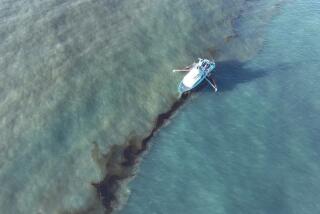World waits to see if ‘top kill’ will stop oil flow in gulf
- Share via
Reporting from Los Angeles and Robert, La. — In an intricate deep-sea operation that was watched as closely and nervously as a high-profile space launch, BP on Wednesday set in motion a crucial effort to stop the flow of crude that for more than a month has fed one of the biggest oil spills in U.S. history.
But hours into the “top kill” procedure, BP executives were not ready to declare victory.
“We will not be rushed. It’s too early to know if it will be successful,” BP Chief Operating Officer Doug Suttles said Wednesday evening. “We’ve ridden a roller coaster, and I think we just need to take the next 24 hours and see what the results are.”
In the meantime, politicians, Gulf of Mexico residents and a public confronted with daily images of the rusty-colored oil slick crossed their fingers that the oil gusher would finally be turned off.
In its simplest sense, top kill relies on brute force. Two vessels on the gulf surface are pumping drilling mud at a high velocity into the blown-out BP wellhead nearly a mile below. If it works, the dense mixture of water and minerals will overcome the pressure of the oil and gas rising in the 13,000-foot-deep well, basically stuffing the flow back down the hole. The wellhead would then be sealed with cement.
By Wednesday afternoon, clouds of sediment from the drilling mud were exiting the leaking riser pipe connected to the well, obscuring the flow of oil.
A BP spokesman also said that engineering teams had discovered in the last week that there was some sort of restriction affecting the oil flow. It could be either in the failed blowout preventer sitting atop the well, or down in the well.
“Perhaps the well is starting to collapse in on itself,” said company spokesman Tom Mueller, who compared the restriction to a pinch in a hose.
Top kill has been used before to plug out-of-control wells, but never at the 5,000-foot depth of the BP leak. Underwater robots operated from the surface had to do the mechanical preparation on the seafloor, connecting two lines running from the pumping vessels to the blowout preventer.
Roomfuls of scientists spent weeks planning the maneuver, relying on supercomputers and gamma-ray imagers to help make crucial pressure calculations. Engineers worked through Tuesday night, running tests. Energy Secretary Steven Chu, a Nobel-winning physicist, joined the diagnostic team in Houston.
The biggest start-up challenge, Suttles said, was analyzing the pressure readings and other data to make sure conditions were right in the remote wellhead. “You can’t touch it. You can’t feel it. You can’t go down there yourself,” he said.
If the top kill isn’t properly executed, BP officials have said it could increase the flow of oil by further damaging the blowout preventer.
But after several failed attempts to stop the stream of crude that has been gushing into the gulf since the April 20 rig explosion that left 11 people dead, BP was ready to take the gamble.
As the untamed spill has grown — closing fisheries, sloshing into vital Louisiana wetlands and threatening gulf beaches — frustration and anger has mounted. Politicians have unhappily joked that BP stands for “beyond patience.”
Local politicians have complained about the federal response, ratcheting up pressure on the Obama administration. The president has sent Cabinet members to the gulf several times and is planning his second trip to the region this weekend.
If the top kill doesn’t work, BP says it is ready with another strategy to capture most of the leak while pursuing other options to plug the well. But the ultimate fix may not come until August, when BP finishes drilling two relief wells to pump mud and cement into the bottom of the blown-out well.
Jim Tankersley in the Washington bureau contributed to this report.
More to Read
Sign up for Essential California
The most important California stories and recommendations in your inbox every morning.
You may occasionally receive promotional content from the Los Angeles Times.












